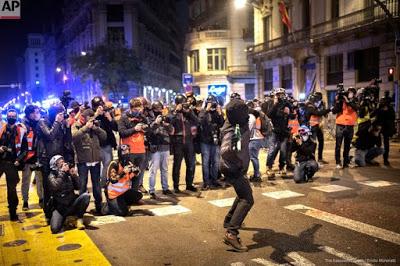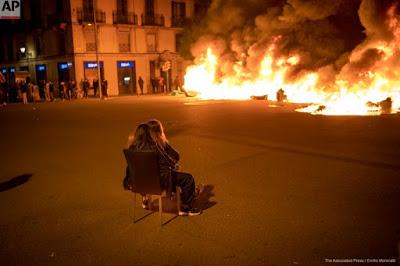
Foto: Emilio Moneratti
Estas semanas se ha hablado mucho de la libertad de expresión a tenor de las imágenes violentas que los medios han viralizado en relación a las protestas por el encarcelamiento de un cantante. El debate se centró en lo justo o injusto de esta medida pero poco se ha reflexionado sobre el problema de fondo: nuestra sociedad padece una falta de comunicación crónica.
El diagnóstico es claro para cualquier profesional que trate con pacientes. Cuando preguntamos ¿usted tiene alguien con quién desahogarse contando sus problemas? la mayoría de las veces la respuesta es negativa. El problema pues no es tanto la libertad de poder decir una u otra cosa sino la posibilidad de encontrar alguien que verdaderamente atienda nuestros asuntos.
El excesivo ruido de fondo que vierten todas las pantallas que tenemos alrededor nos distrae de lo importante, nadie tiene tiempo para escuchar con calidad al otro, ni siquiera a uno mismo.
Y a la hora de expresarnos, ¿cómo lo hacemos?. Si miramos un poco las redes sociales veremos que no muy bien. Predomina la queja, el insulto, el enfado. Hay pocos ejemplos de diálogo pacífico o de choques de argumentos opuestos hechos desde la educación y el buen trato. En los medios pasa lo mismo, lo habitual es la bronca, el grito o el improperio, los focos siguen a los que peor lengua gastan.
Uno de los canales de comunicación humana más importantes es el de la creatividad y las bellas artes, otro frente en crisis total. ¿Podrían poner ejemplos de creaciones artísticas contemporáneas que les inspiren?, haberlos los hay, pero son escasos o tienen poca visibilidad. Preferimos lo zafio, escandaloso o brutal y desdeñamos lo delicado, estilizado o simplemente bello.
La libertad de expresión es un derecho ciudadano que como las demás libertades tiene un límite, el derecho del otro. La expresión ofensiva ha de ser prudente, si no lo es puede herir o atentar contra los demás. Donde no hay límite es en la libertad de escucha, ¿seremos capaces de mejorar esta libertad o tan solo nos centraremos en gritar cada cual lo que le plazca?
Son tiempos proclives a la reflexión ética. Lástima que nos solamos quedar en superficie y no aprovechemos las oportunidades para remar un poco mar adentro.

Foto: Emilio Moneratti
Healing expression, healing communication.
In recent weeks, there has been much talk about freedom of expression in the light of the violent images that the media have viralised in relation to the protests against the imprisonment of a singer. The debate focused on the fairness or unfairness of this measure but little thought has been given to the underlying problem: our society suffers from a chronic lack of communication.
The diagnosis is clear to any professional dealing with patients. When we ask the question: "Do you have someone to talk to about your problems? Most of the time the answer is negative. The problem, then, is not so much the freedom to say one thing or another, but the possibility of finding someone who will really deal with our issues.
The excessive background noise from all the screens around us distracts us from what is important, nobody has time to listen to the other person, not even to oneself.
And when it comes to expressing ourselves, how do we do it? If we take a look at the social networks we will see that not very well. Complaints, insults and anger predominate. There are few examples of peaceful dialogue or clashes of opposing arguments based on education and good treatment. In the media, the same thing happens, the usual thing is the brawl, the shouting or the insult, the spotlight follows those who use the worst language.
One of the most important channels of human communication is that of creativity and the fine arts, another front in total crisis. Could you give examples of contemporary artistic creations that inspire you, there are some, but they are scarce or have little visibility. We prefer the crude, scandalous or brutal and disdain the delicate, stylised or simply beautiful.
Freedom of expression is a civil right which, like all other freedoms, has a limit, the right of others. Offensive expression must be prudent; if it is not, it can hurt or offend others. Where there is no limit is in the freedom to listen. Will we be able to improve this freedom or will we just focus on shouting whatever we want?
These are times for ethical reflection. It is a pity that we tend to stay on the surface and do not take advantage of opportunities to put out into the deep.
治愈表情,恢復溝通。
自動翻譯,對錯誤感到抱歉。
近幾週來,鑑於媒體對與歌手監禁有關的抗議聲名ral起,暴力言論已經引起了很多討論。辯論的重點是這種措施的公平性或不公平性,但很少有人思考這個潛在問題:我們的社會長期缺乏交流。
任何與患者打交道的專業人員都可以明確診斷。當我們問一個問題時:“您是否有人來談論您的問題?在大多數情況下,答案是否定的。那麼,問題不在於說一件事情或另一件事情的自由,而是找到一個真正會處理我們問題的人。
來自我們周圍所有屏幕的過多背景噪音使我們無法注意重要的事情,沒有人有時間聽別人,甚至沒有時間聽自己的話。
在表達自我時,我們該如何做呢?如果我們看一下社交網絡,我們會發現情況不是很好。投訴,侮辱和憤怒居多。很少有基於教育和良好待遇的和平對話或對立論據衝突的例子。在媒體上,同樣的事情發生了,通常的事情是鬥毆,大喊大叫或侮辱,聚光燈跟隨那些使用最惡劣語言的人。
人類交流的最重要渠道之一是創造力和美術,這是全面危機中的另一條戰線。您能舉一些啟發您的當代藝術創作的例子嗎?雖然有些,但它們很少或幾乎沒有知名度。我們更喜歡粗俗,醜聞或殘酷的事物,而鄙視精緻,風格化或簡單的美麗。
言論自由是一項公民權利,與所有其他自由一樣,它也具有他人的權利。冒犯性表達必須謹慎;如果不是這樣,它可能會傷害或冒犯他人。沒有限制的地方就是聆聽的自由。我們將能夠改善這種自由,還是只專注於喊什麼我們想要的?
這是道德反思的時代。遺憾的是,我們傾向於停留在表面上,不利用任何機會深入到深處。
